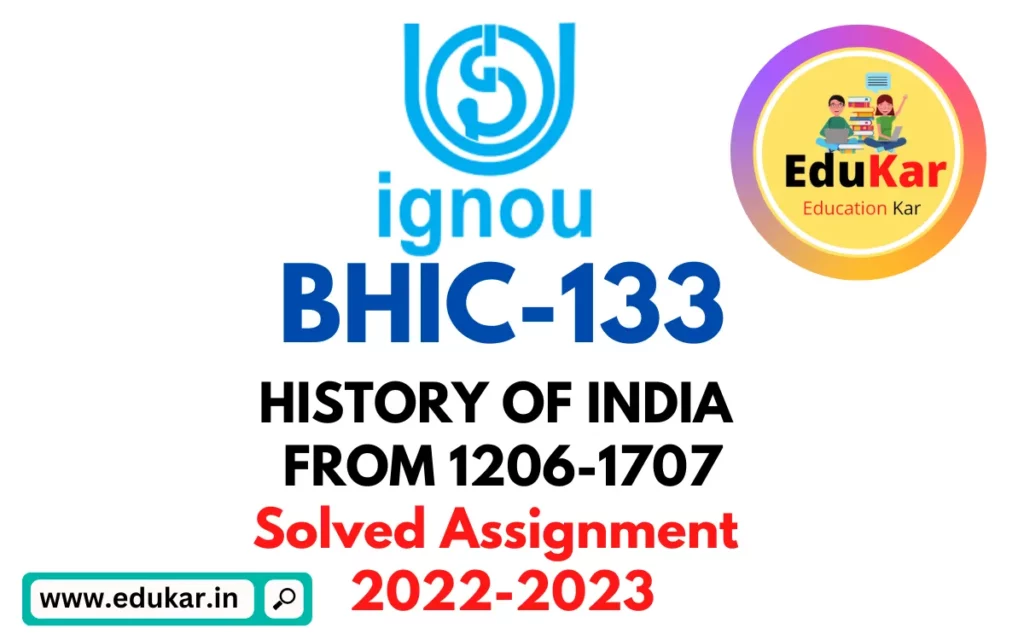Contents
- 1 Assignment – I
- 2 Answer the following in about 500 words each.
- 3 1. Discuss briefly the Mongol policy of the Delhi Sultans.
- 4 2. Explain ritual kingship in the context of Vijayanagara empire. Mention the role and functions of the Brahmanas in the Vijayanagara empire.
- 5 Assignment – II
- 6 Answer the following questions in about 250 words each.
- 7 3. Analyse Turkan-i Chihilgani. Discuss the role played by Turkan-i Chihilgani as kingmakers after the death of Iltutmish.
- 8 4. Discuss the currency system of the Delhi Sultans.
- 9 5. Write a brief note on the growth of sufi movement in India.
- 10 Assignment – III
- 11 Answer the following questions in about 100 words each.
- 12 6. Persian chroniclers of the Sultanate period.
- 13 7. Role of amiran-i sadah in making the Deccan independent of the Tughlaq rule.
- 14 8. Medieval Assam.
- 15 9. Military technology during the sultanate period.
- 16 10. Slaves and karkhanas during the Sultanate period.

| Title | BHIC-107: IGNOU BAG Solved Assignment 2022-2023 |
| University | IGNOU |
| Degree | Bachelor Degree Programme |
| Course Code | BHIC-107 |
| Course Name | HISTORY OF INDIA-IV |
| Programme Name | Bachelor of Arts (General) |
| Programme Code | BAG |
| Total Marks | 100 |
| Year | 2022-2023 |
| Language | English |
| Assignment Code | BHIC-107/ASST/TMA/2022-23 |
| Last Date for Submission of Assignment: | For June Examination: 31st April For December Examination: 30th September |

Assignment – I
Answer the following in about 500 words each.
1. Discuss briefly the Mongol policy of the Delhi Sultans.
Ans: The Delhi Sultans, who ruled the Delhi Sultanate in northern India from the 13th to the 16th centuries, adopted a policy towards the Mongols that was characterized by both military opposition and diplomatic engagement. The Mongol Empire, under the rule of Genghis Khan and his descendants, had established a vast empire that extended from Central Asia to Europe, and the Delhi Sultans saw the Mongols as a major threat to their own rule.
Despite their military might, the Delhi Sultans did not adopt a solely confrontational approach towards the Mongols. Instead, they pursued a policy of balancing military opposition with diplomatic engagement. On one hand, they fortified their cities and built up their armies in preparation for potential Mongol invasions. On the other hand, they also sent diplomatic missions to the Mongol court in an effort to establish cordial relations and negotiate alliances.
One notable example of this policy was the reign of Sultan Alauddin Khalji (r. 1296-1316), who sought to establish friendly relations with the Mongols in order to counter the threat posed by the Mongol ruler Ghazan. Alauddin sent envoys to Ghazan’s court with gifts, and Ghazan responded by sending his own envoys to the Delhi court. Despite these efforts, however, the relationship between the two powers remained strained and both sides remained ready for military confrontation.
During the reign of Sultan Muhammad bin Tughlaq (r. 1325-1351), the Delhi Sultanate faced multiple invasions from the Mongols. Despite initial military successes, the Delhi Sultans were ultimately unable to repel the Mongol advances, and the Sultanate suffered significant territorial losses as a result.
In the late 14th and early 15th centuries, the Delhi Sultanate faced another wave of Mongol invasions, this time led by Timur (also known as Tamerlane). Timur, who had established a vast empire in Central Asia and Iran, launched a series of invasions into northern India, capturing and looting the major cities of Delhi and Meerut. The Delhi Sultanate was left weakened and vulnerable, and it eventually fell to the hands of the Mughals in the 16th century.
2. Explain ritual kingship in the context of Vijayanagara empire. Mention the role and functions of the Brahmanas in the Vijayanagara empire.
Ans:
Ritual kingship was an important aspect of the Vijayanagara Empire, which was established in South India in the 14th century and lasted until the late 16th century. The Vijayanagara rulers claimed divine origin and saw themselves as the embodiment of divine power on earth. This concept of ritual kingship was rooted in Hindu tradition and was reinforced through various religious and ceremonial practices.
One important aspect of ritual kingship in the Vijayanagara Empire was the performance of royal rituals and ceremonies that symbolized the ruler’s divine status. These rituals included the installation of the king on the throne, the consecration of the king with sacred oils, and the performance of yajnas (fire sacrifices). The performance of these rituals was intended to demonstrate the king’s connection to the divine and to reinforce his legitimacy as ruler.
In addition to these religious ceremonies, the Vijayanagara kings also sought to demonstrate their power and wealth through the construction of monumental temples and palaces, as well as through their patronage of the arts. The Vijayanagara kings were also known for their patronage of poets, scholars, and other cultural figures, and their reign was marked by a flourishing of literary, artistic, and architectural activity.
The role and functions of the Brahmanas in the Vijayanagara Empire were complex and multifaceted. Brahmanas were members of the highest caste in Hindu society and were considered to be the guardians of Hindu religious and cultural traditions. They were also seen as possessing spiritual and intellectual authority, and they played an important role in the administration of the empire.
In the Vijayanagara Empire, the Brahmanas served as advisors to the king, and they were involved in the formulation of policies and the administration of justice. They also served as temple priests and performed important religious ceremonies and rituals, including the consecration of the king. The Brahmanas also played an important role in the education and cultural development of the empire, and they were involved in the patronage of scholars, poets, and artists.
Assignment – II
Answer the following questions in about 250 words each.
3. Analyse Turkan-i Chihilgani. Discuss the role played by Turkan-i Chihilgani as kingmakers after the death of Iltutmish.
Ans: Turkan-i Chihilgani, also known as the Forty Turks, were a group of 40 Turkish slave soldiers who rose to prominence in the Delhi Sultanate during the reign of Iltutmish. After the death of Iltutmish, the Forty Turks played a significant role as kingmakers in the selection of the next Sultan.
After Iltutmish’s death, the Forty Turks were instrumental in the selection of Razia Sultan as the next ruler. Razia was the first and only female Sultan of the Delhi Sultanate, and her selection as the ruler was seen as a significant event in the history of the region. The Forty Turks supported Razia due to her capability and the fact that she was a member of Iltutmish’s family. However, her rule was short-lived, and she was eventually overthrown and replaced by Altunia, who was supported by the Forty Turks.
The role of the Forty Turks as kingmakers continued even after the reign of Razia and Altunia. They supported several other Sultans who came to power, including Nasiruddin Mahmud and Ghiyasuddin Balban. The Forty Turks were known for their military prowess and were a formidable force in the Delhi Sultanate. They were responsible for maintaining law and order and protecting the Sultanate from external threats.
However, their power and influence also made them the target of several rival factions who sought to overthrow them. Eventually, their influence waned, and they lost their power as kingmakers. Nevertheless, the legacy of the Forty Turks remains an important part of the history of the Delhi Sultanate.
4. Discuss the currency system of the Delhi Sultans.
Ans: The currency system of the Delhi Sultans was a complex and dynamic system that evolved over time in response to the changing needs of the empire. During the early period of the Delhi Sultanate, the currency system was based on the use of coins from the earlier Hindu kingdoms and local currencies. The Sultans also issued their own coins, which were often modeled after the coins of the earlier Hindu kingdoms. These coins were made of silver and copper and were used for local transactions.
With the growth of trade and commerce, the Sultans began to issue gold coins, which were more suitable for long-distance trade. These gold coins were called dinars and were based on the design of the coins used in the Abbasid caliphate. The Sultans also issued silver coins, which were called tankas, and these were used for smaller transactions.
In addition to the issuance of coins, the Sultans also relied on paper currency, which was known as paisa. The paisa was a form of IOU that could be redeemed for a certain amount of gold or silver. This form of currency was particularly useful in times of war, as it allowed the Sultans to quickly raise funds without having to mint new coins.
The currency system of the Delhi Sultans was also influenced by the monetary systems of the neighboring countries, such as Iran and Central Asia. The Sultans frequently exchanged currency with these countries, which helped to standardize the currency system and make it more uniform across the empire.
5. Write a brief note on the growth of sufi movement in India.
Ans: The growth of the Sufi movement in India took place during the medieval period and played a significant role in the spread of Islam in the region. Sufism, which emphasizes the mystical and spiritual aspects of Islam, was introduced to India by Persian and Central Asian Sufi saints who arrived in the region in the 12th and 13th centuries.
These Sufi saints, who were known as “Pir” or “Shaikh,” established spiritual centers (known as “khanaqah” or “dargah”) where they taught their followers about the tenets of Sufism and provided spiritual guidance. These centers also served as hubs for cultural and intellectual exchange, and helped to spread the Sufi teachings throughout the region.
One of the most famous Sufi saints to arrive in India was Moinuddin Chishti, who established a spiritual center in Ajmer that became a major center of Sufi activity. Other Sufi saints, such as Nizamuddin Auliya and Qutbuddin Bakhtiar Kaki, established similar centers in Delhi that also became important centers of Sufi activity.
The Sufi saints also helped to bridge the gap between different religious communities in India by promoting a message of unity and tolerance. They emphasized the importance of love and compassion in the practice of Islam, and encouraged their followers to embrace the diversity of Indian culture.
The Sufi movement in India also had a significant impact on the development of local languages and literatures. Sufi poetry and music, which emphasized the themes of love and devotion, became an important part of the local cultural heritage and helped to spread the Sufi teachings to a wider audience.
Assignment – III
Answer the following questions in about 100 words each.
6. Persian chroniclers of the Sultanate period.
Ans: Persian chroniclers were important figures during the Sultanate period in India (1206-1526), as they recorded the events of the time and helped to shape our understanding of this era. The Persian chroniclers were typically court historians, who served the rulers of the Delhi Sultanate and wrote in the Persian language.
Notable Persian chroniclers from the Sultanate period include Amir Khusrau, Barani, and Yahya bin Ahmad Sirhindi. These chroniclers wrote about the political and military events of the time, as well as the social, cultural, and religious life of the people. They also recorded the administrative policies of the sultans, the growth and decline of the sultanate, and the cultural interactions between the Muslims and Hindus.
The works of these chroniclers provide valuable insights into the history of the Sultanate period, and they continue to be widely studied and referenced by historians and scholars today. They are also considered important sources of information on the cultural, religious, and social life of the people of India during the Sultanate period.
7. Role of amiran-i sadah in making the Deccan independent of the Tughlaq rule.
Ans: The amiran-i sadah, or “the chief of the army,” played an important role in making the Deccan region of India independent of the Tughlaq rule. During the Tughlaq dynasty (1320-1414), the Deccan region was ruled by the governor of the Tughlaq empire, and the amiran-i sadah was the commander of the governor’s army.
However, over time, the amiran-i sadah became powerful and began to assert his independence from the Tughlaq ruler. He formed alliances with local rulers and gradually established himself as the de facto ruler of the Deccan region. By the end of the Tughlaq dynasty, the amiran-i sadah had succeeded in making the Deccan region independent from the Tughlaq rule.
The amiran-i sadah was also instrumental in paving the way for the establishment of the Bahmani Kingdom, which was one of the most powerful states in the Deccan region during the 15th century. He was able to use his military power and administrative skills to establish a stable and prosperous state in the Deccan, which became a model for future states in the region.
8. Medieval Assam.
Ans: Medieval Assam refers to the period of history in the northeastern Indian state of Assam between the 9th and the 16th centuries. During this time, Assam was ruled by a series of dynasties, including the Pala dynasty, the Kamarupa kingdom, and the Ahom kingdom.
The Kamarupa kingdom was one of the most powerful states in medieval Assam and controlled a large portion of present-day Assam, as well as parts of present-day Bengal and Bangladesh. The kingdom was known for its military prowess, and it successfully resisted attempts by the Mughal Empire to conquer it.
The Ahom kingdom, which ruled Assam from the 13th century until the late 19th century, was known for its stability and prosperity. The Ahom kings were able to maintain a centralized administration, and they implemented a number of reforms to improve the lives of their subjects. The kingdom was also known for its cultural achievements, and it produced a rich legacy of literature, art, and architecture.
9. Military technology during the sultanate period.
Ans: The military technology during the Sultanate period in India (1206-1526) was characterized by the use of advanced weapons and tactics. The soldiers of the Sultanate army were equipped with a variety of weapons, including swords, shields, maces, and spears, as well as more advanced weapons like crossbows and muskets.
The Sultanate army also made use of advanced tactics, such as the use of siege engines and the deployment of large numbers of horse-mounted soldiers, known as cavalry. The cavalry played a key role in the Sultanate army’s success, as they were able to move quickly across the battlefield and engage the enemy in hand-to-hand combat.
In addition to the use of advanced weapons and tactics, the Sultanate army also made use of elephants in battle. Elephants were highly valued for their size and strength, and they were often used to break through enemy lines or to protect the flanks of the Sultanate army.
The Sultanate period saw the introduction of new military technologies from the Islamic world, such as the use of gunpowder and the development of firearms. These new technologies helped to give the Sultanate army a significant advantage over their opponents and played a key role in their military successes.
10. Slaves and karkhanas during the Sultanate period.
Ans: During the Sultanate period in India (1206-1526), the use of slaves and karkhanas, or imperial workshops, played an important role in the functioning of the state and the economy.
Slaves were widely used in the Sultanate period, both in households and in government institutions. They performed a variety of tasks, including manual labor, household chores, and military service. Some slaves were also trained in specialized crafts, such as weaving or blacksmithing, and were employed in the karkhanas.
Karkhanas were imperial workshops established by the Sultanate rulers to produce goods for the state and for the ruling class. These workshops were run by slaves, who were trained in specialized crafts and were responsible for producing goods such as textiles, weapons, and jewelry. Karkhanas were also responsible for the production of luxury goods for the court, and many of these goods were exported to other parts of the Islamic world.
The use of slaves and karkhanas helped the Sultanate rulers to maintain a strong and centralized state, as they were able to control the production of goods and the labor force. This, in turn, allowed the Sultanate rulers to maintain their dominance over the population and to fund their military campaigns and state-building projects.
How to Download BHIC-107 Solved Assignment?
You can download it from the www.edukar.in, they have a big database for all the IGNOU solved assignments.
Is the BHIC-107 Solved Assignment Free?
Yes this is absolutely free to download the solved assignment from www.edukar.in
What is the last submission date for BHIC-107 Solved Assignment?
For June Examination: 31st April, For December Examination: 30th October
















